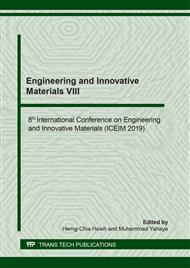[1]
Abioye, A. M and Ani, F.N.,2015, Recent development in the production of activated carbon electrodes from agricultural waste biomass for supercapacitors: A review. Renewable and Sustainable Energy Reviews 5, p.1282–1293.
DOI: 10.1016/j.rser.2015.07.129
Google Scholar
[2]
Taer. E., M. Deraman., R.Taslim., Iwantono. 2013. Preparation of binderless activated carbon monolith from pre-carbonization rubber wood sawdust by controlling of carbonization and activation condition in the 4th Nanoscience and Nanotechnology Symphosium (NNS)- AIP/ Conference Proceedings 1554, American Insitute of Physic, Melville, NY. pp.33-37.
DOI: 10.1063/1.4820277
Google Scholar
[3]
Taer E., Yusra H., Iwantono., Taslim R., 2016, Analisa Dimensi, Densitas dan kapasitansi Spesifik Elektroda Karbon Superkapasitor dari Bunga Rumput Gajah dengan Variasi Konsentrasi Pengaktifan KOH, Jurnal Fisika dan Aplikasinya, vol. 1, no. 1, pp.2541-3384.
DOI: 10.21009/spektra.011.09
Google Scholar
[4]
Basri N.H., Deraman M., Suleman M., Nor N.S.M., Dolah B.S.M., Sahri M.I., Aisyah S.S., 2016, Energy and Power of Supercapacitor Using Carbon Electrode Deposited with Nanoparticles Nickel Oxide. International Journal of Electrochemical science, pp.95-110.
DOI: 10.4028/www.scientific.net/amr.1112.236
Google Scholar
[5]
J.S. Nazzal, W. Kaminska, B. Michalkiewicz, dan Z.C. Koren, 2013, Production, characterization and methane storage potential of KOH-activated carbon from sugarcane molasses. Industrial Crops and Products, 47, p.153– 159.
DOI: 10.1016/j.indcrop.2013.03.004
Google Scholar
[6]
Wijaya M.M., Wiharto M., 2017, Karakterisasi Kulit Buah Kakao untuk Karbon Aktif dan Bahan Kimia yang Ramah Lingkungan, Jurnal Kimia dan pendidikan Kimia, vol 2, Hal. 66-71.
DOI: 10.35580/chemica.v20i1.13620
Google Scholar
[7]
Cruz G., Pirila M., Huuhtanen M., Carrion L., Alvarenga E., and Keiski R.L., 2012, Production of Activated Carbon from Cocoa (Theobroma cacao) Pod Husk, Journal Civil Environment, pp.2165-7842.
DOI: 10.4172/2165-784x.1000109
Google Scholar
[8]
Yetri. Y., Emriadi, Novesar Jamarun and Gunawarman, 2015, Corrosion Inhibitor of Mild Steel by Polar Extract of Theobroma cacao Peels in Hydrochloric Acid Solution, Asian Journal of Chemistry, vol. 27, np. 3, pp.875-881.
DOI: 10.14233/ajchem.2015.17173
Google Scholar
[9]
Yetri Y., Emriadi, Novesar J and, Gunawarman, 2016, Corrosion Behavior of Environmental Friendly Inhibitor of Theobroma cacao Peels Extract for Mild Steel in NaCl 1.5 M, EnvironmentAsia, vol. 9 no.1, pp.45-59.
DOI: 10.5772/intechopen.73263
Google Scholar
[10]
Yetri Y., and Sukatik, 2017, Green Inhibitor for Mild Steel in Acidic Solution by Using Crude Extract and Polar Extract of Theobroma cacao Peels, Oriental Journal of Chemistry, vol. 33 no.4, pp.2071-2079.
DOI: 10.13005/ojc/330456
Google Scholar
[11]
Yetri Y., Emriadi, Novesar Jamarun and, Gunawarman, 2016, Inhibitory Action of Theobroma cacao Peels Extract on Corrosion of Mild Steel in Different Media, Rasayan Journal of Chemistry, vol. 9, No. 4, pp.716-727.
DOI: 10.5772/intechopen.73263
Google Scholar
[12]
Yetri Y., Sukatik, Ruzita Sumiati, and Rahmi Hidayati, 2018, The Effect of Size and Composition Variation of Cacao (Theobroma cacao) Peels Powder with Bagasse Fillers to Physical and Mechanical Properties of Particle Board, International Journal of Applied and Physical Sciences, vol. 4, no. 2 pp.50-58.
DOI: 10.20469/ijaps.4.50003-2
Google Scholar
[13]
Yetri Y., Gunawarman , Emriadi, and, Novesar Jamarun, 2017, Theobroma cacao Extract Peels (TCPE) Green Inhibitor to Recovery the Mechanical Properties of Mild Steel After Corrosion, ARPN Journal of Engineering and Applied Sciences, vol. 12, no. 12, pp.5325-5332.
DOI: 10.5772/intechopen.73263
Google Scholar
[14]
Taer E.,Taslim R., 2018, Preparation Techniques of Biomass Based Activated Carbon Monolith Electrode for Supercapacitor Applications, AIP Conference Proceedings 1927, 020004;.
DOI: 10.1063/1.5021192
Google Scholar
[15]
Deraman, M., Daik, R., Soltaninejad, S., Mohd Nor, N. S., Awitdrus., Farma, R., Mamat, N. F., Basri, N. H., Othman, M. A. R., 2015. A New Equation for Estimating Spesific Surface Area of Supercapacitor Carbon Electrode from X-ray Difraction, Advanced Materials Reschearch. 1108. 1-7.
DOI: 10.4028/www.scientific.net/amr.1108.1
Google Scholar
[16]
Subramanian, C. Luo, A.M. Stephan, K.S Nahm, and S. Thomas B. Wei, 2007, Supercapacitors from Activated Carbon Derived from Banana Fibers. J. Phys. Chem. C., 111, 7527.
DOI: 10.1021/jp067009t
Google Scholar
[17]
W-J. Liu, K. Tian, Y-R. He, H. Jiang, and H-Q. Yu, 2014, High-yield Harvest of Nanofibers/Mesoporous Carbon Composite by Pyrolysis of Waste Biomass and Its Application for High Durability Electrochemical Energy Storage, Environ. Sci. Technol., 48, 13951.
DOI: 10.1021/es504184c
Google Scholar
[18]
C. Kim, J. W. Lee, J. H. Kim, and K. S. Yang, 2006, Feasibility of bamboo-based activated carbons for annelectrochemical supercapacitor electrode, Korean J. Chem. Eng. 23, 592-594.
DOI: 10.1007/bf02706799
Google Scholar
[19]
E. Taer, A. Apriwandi, Krisman, Minarni,R. Taslim, A. Agustino, and A. Afrianda, The physical and electrochemical properties of activated carbon electrode made from pandanus tectorius, J. Phys.:Conf. Ser. 1120 (2018) 012006.
DOI: 10.1088/1742-6596/1120/1/012006
Google Scholar
[20]
E Taer, A Afrianda, R Taslim, Krisman, Minarni, A Agustino, A Apriwandi, and U Malik, The physical and electrochemical properties of activated carbon electrode made from Terminalia Catappa leaf (TCL) for supercapacitor cell application, J. Phys.: Conf. Ser. 1120 (2018) 012007.
DOI: 10.1088/1742-6596/1120/1/012007
Google Scholar


